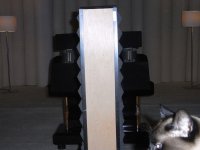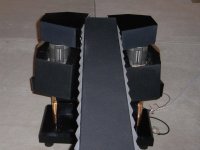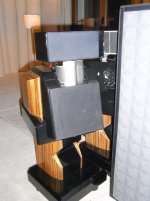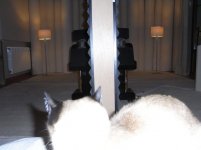I stripped the barrier to a bare minimum and it works really well. It´s got my cat´s golden ears´ approval. Settings are 20 us delay and no recursion whatsoever. Speakers toed out except for the tweeters (or supertweeters since they`re crossed very high)
Attachments
One more impressed guy here.
Combinating the mechanical and software cancellations is a great idea, and finally it's not that intrusive. How long is your barrier ?
Combinating the mechanical and software cancellations is a great idea, and finally it's not that intrusive. How long is your barrier ?
love the barrier.
I've wanted to try the barrier then using sine waves, vary the level on 1 channel, and also vary the phase to see what would happen to the image.
Norman
I've wanted to try the barrier then using sine waves, vary the level on 1 channel, and also vary the phase to see what would happen to the image.
Norman
One more impressed guy here.
Combinating the mechanical and software cancellations is a great idea, and finally it's not that intrusive. How long is your barrier ?
I can't stop thinking that this has something in common with Stereolith, the loudspeakers are toed out - let's toe them out further and eventually You get Stereolith-like configuration
in fact this is how I arrived at my first stereolith-like loudspeaker - I was toeing out - my goal was an ambiopole without eye-crossing at a physical barrier nor digital processing
Last edited:
The barrier is merely 1 meter long.Combinating the mechanical and software cancellations is a great idea, and finally it's not that intrusive. How long is your barrier
Interesting idea. I would try it too if I had the equipment. Please post your findings when you do.I've wanted to try the barrier then using sine waves, vary the level on 1 channel, and also vary the phase to see what would happen to the image
The toeing out is indeed intriguing. It makes a huge difference to the experience.I can't stop thinking that this has something in common with Stereolith, the loudspeakers are toed out
Last edited:
I've wanted to try the barrier then using sine waves, vary the level on 1 channel, and also vary the phase to see what would happen to the image
To norman: what's your theory about this?
I am seriously very interested by your conclusions.
lol, theory ?
I know that no right sound throws the image far to the left.
Therefore, I assume the phase won't do anything at all to the image placement.
Poldus, could you play some mono material and have someone turn the balance control ?
Norman
I know that no right sound throws the image far to the left.
Therefore, I assume the phase won't do anything at all to the image placement.
Poldus, could you play some mono material and have someone turn the balance control ?
Norman
Ok, 😀 I said this because in two different systems with no standard radiating patterns and no ambio process, I have to admit that some well done phase shifts on some frequencies make a difference of 100% in imaging (not spaciousness only).
Its hard to accept, even for me, that's why I search desperately an explanation or other similar experiences. 😕
Its hard to accept, even for me, that's why I search desperately an explanation or other similar experiences. 😕
What do you do about modern recordings, which already have all that stuff taken into account? The principal has been known for a long time. Recording engineers are hip to it. I was just listening to Laurie Anderson's Life On a String (2001) for the forty-eleventh time. It achieves surround-sound from two speakers. It has all sorts of whiz-bang effects like percussion thingies crossing from in front, over your head, and to the rear. I assume that would be destroyed by a setup as described.
I know what interaural distortion sounds like. Very few of my recordings have it when played through loudspeakers.
I know what interaural distortion sounds like. Very few of my recordings have it when played through loudspeakers.
Hello,
Also it is well known that cross talk cancellation do not work very well with widely spaced speakers, like conventional stereo configuration (individual HRTF variation, head movement, sweet spot size etc.).
It's better to place the speakers in front in narrow spatial angle to overcome most of the problems.
- Elias
Also it is well known that cross talk cancellation do not work very well with widely spaced speakers, like conventional stereo configuration (individual HRTF variation, head movement, sweet spot size etc.).
It's better to place the speakers in front in narrow spatial angle to overcome most of the problems.
- Elias
What do you do about modern recordings, which already have all that stuff taken into account? The principal has been known for a long time. Recording engineers are hip to it. I was just listening to Laurie Anderson's Life On a String (2001) for the forty-eleventh time. It achieves surround-sound from two speakers. It has all sorts of whiz-bang effects like percussion thingies crossing from in front, over your head, and to the rear. I assume that would be destroyed by a setup as described.
I know what interaural distortion sounds like. Very few of my recordings have it when played through loudspeakers.
Dave Jones, your are absolutely wise to think of the issue you mention. But it's one of the things that gets all my attention (also because it's easier to analyse , very revealing and so fun to listen loud 😀).
With appropriate phase shifts, it's not a soundstage distorsion but rather a rehabilitation. Why? dunno yet. I have actually two very different speakers with central HF, as says Elias, and both make these kind of records very spectacular. Must be different with conventional setups.
With appropriate phase shifts, it's not a soundstage distorsion but rather a rehabilitation. Why? dunno yet. I have actually two very different speakers with central HF, as says Elias, and both make these kind of records very spectacular. Must be different with conventional setups.
Hello,
Also it is well known that cross talk cancellation do not work very well with widely spaced speakers, like conventional stereo configuration (individual HRTF variation, head movement, sweet spot size etc.).
It's better to place the speakers in front in narrow spatial angle to overcome most of the problems.
- Elias
My point is that the "cross talk" in modern recordings is understood by the recording engineers and the talk that crosses is intentional. Not bug; Feature.
BTW, I owned a "Sonic Hologram" processor ca. 1981.
I have no mono cd but I will route, say, the left channel output from the player into both left and right inputs to the ambio, then sweep the balance control. I will post what I hear over the weekend.Poldus, could you play some mono material and have someone turn the balance control ?
What do you do about modern recordings, which already have all that stuff taken into account? The principal has been known for a long time. Recording engineers are hip to it. I was just listening to Laurie Anderson's Life On a String (2001) for the forty-eleventh time. It achieves surround-sound from two speakers. It has all sorts of whiz-bang effects like percussion thingies crossing from in front, over your head, and to the rear. I assume that would be destroyed by a setup as described.
I know what interaural distortion sounds like. Very few of my recordings have it when played through loudspeakers.
I'm running an ambio setup at home, and in the car. I've generally found the opposite to be true. A lot of these recording tricks are *more* sensational on an ambio setup than on a conventional setup.
Here's a little experiment you can do to see what I mean:
Take your speakers, and invert the phase of one speaker. Give them a listen for a few minutes. Then get up, and move them very very close together. The fix the phase, and listen for a few minutes.
Now flip the phase on one speaker, and listen again.
You should notice that the phasing problem is *much* more audible when the speakers are close together.
The reason for this experiment is to demonstrate that changes in phase are more audible with drivers that are in close proximity, and many of these studio tricks depends on manipulation of phase.
I routed one side only of the stereo output from the CD into both channels of the ambio processor. The sound of course was mono and was perceived to come from where the speakers are. By turning the balance knob the sound came from only one of the speakers, but again, it was perceived to come from where that speaker was. There was no spread of sound beyond the speaker´s limits whatsoever.
Norman: you don´t mean the effect will be there when playing a mono signal through the ambio, do you? Otherwise, sure, Roger Waters and Pink FLoyd have sound effects that really stand out in an ambio set-up. But then there are plenty of records full of surprises out there.try "amused to death" by roger waters, crickets seem waaaaayyyyy out there
- Home
- Loudspeakers
- Multi-Way
- Try Ambiophonics with your speakers



